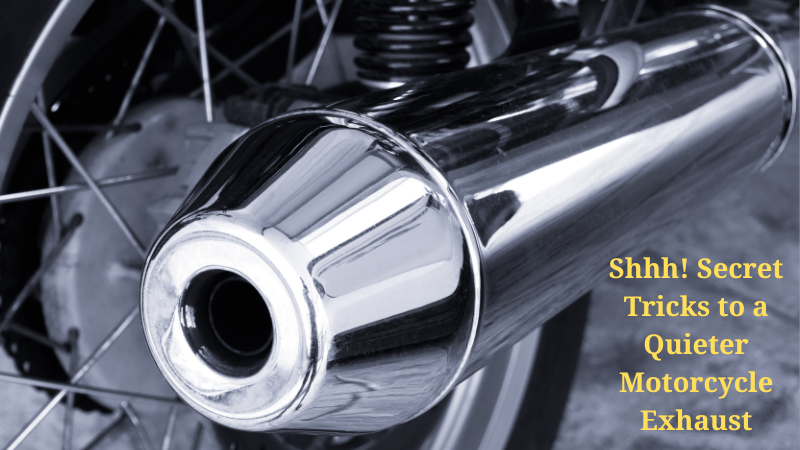Motorcycles are thrilling, efficient, and a joy to ride. But their exhaust noise can be bothersome. This is especially true in residential areas, early in the morning, or when trying to follow local noise rules. If you want to quiet your motorcycle exhaust but keep the performance, this guide will show you different effective ways to do it.

Why Reduce Motorcycle Exhaust Noise?
Before jumping into the solutions, it’s important to understand why reducing motorcycle exhaust noise can be beneficial:
- Legal Compliance: Many areas have strict noise rules for motorcycles. Too much noise can result in fines or even impoundment.
- Consideration for Others: A loud exhaust can upset neighbours, pedestrians, and other drivers, especially in quiet residential areas.
- Personal Comfort: Excessive noise can cause fatigue and hearing issues for riders over time.
- Enhanced Riding Experience: A quieter ride allows you to focus more on the feel of the road and less on the roar of your bike.
1. Install a Quiet Baffle
What is a Baffle?
A baffle is a part inside the exhaust pipe. It helps reduce noise by disrupting the flow of exhaust gases and sound waves. Most stock motorcycles have baffles. However, aftermarket changes or worn parts can make them louder.
How to Install a Quiet Baffle
- Buy a Quiet Baffle: Many brands make quiet baffles for different exhaust types.
- Remove the Old Baffle (if applicable): If your motorcycle already has a baffle but it’s too loud, remove it by unscrewing or cutting it out.
- Insert the New Baffle: Place the quieter baffle into the exhaust pipe and secure it with bolts or weld it in place.
- Test the Noise Level: Start your bike to check if the noise reduction meets your expectations.
Pros:
- Simple and cost-effective solution
- Readily available for various exhaust systems
- Easy to install and remove
Cons:
- May slightly reduce performance by restricting airflow
- Not all baffles fit aftermarket exhausts
2. Use an Exhaust Silencer
What is an Exhaust Silencer?
An exhaust silencer, also known as a “db killer,” is a removable insert placed at the exhaust tip to reduce noise levels. It works by disrupting the sound waves and slowing down the exhaust gases.
How to Install an Exhaust Silencer
- Choose the Right Size: Measure the diameter of your exhaust tip to ensure a proper fit.
- Insert the Silencer: Push it into the exhaust tip and secure it with screws or clamps.
- Test the Sound Reduction: Start the engine and rev it to determine how much noise reduction is achieved.
Pros:
- Affordable and easy to install
- Doesn’t require permanent modifications
- Can be removed when not needed
Cons:
- Some silencers may slightly affect performance
- Not as effective for very loud exhausts
3. Wrap the Exhaust with Heat Wrap
What is Exhaust Heat Wrap?
Exhaust heat wrap is a material that insulates the exhaust pipes, helping to contain heat and reduce sound resonance.
How to Apply Heat Wrap
- Clean the Exhaust Pipes: Remove dirt and rust to ensure better adhesion.
- Soak the Wrap in Water: This makes it more flexible and easier to apply.
- Wrap Tightly Around the Exhaust: Start from the header and work your way down, overlapping by about 1/4 inch.
- Secure with Clamps or Wire Ties: Ensure the wrap stays in place to prevent unraveling.
Pros:
- Reduces noise and enhances heat management
- Improves engine efficiency by keeping heat inside the exhaust
- Adds a custom aesthetic look
Cons:
- Requires periodic maintenance
- Can cause excessive heat buildup in some cases
4. Upgrade to a Quieter Muffler
Why Consider a New Muffler?
Stock or aftermarket performance mufflers are often designed for power rather than noise control. Upgrading to a quieter muffler can significantly reduce noise levels without compromising performance.
Steps to Replace Your Muffler
- Choose a Quiet Muffler: Look for brands specializing in low-noise options.
- Remove the Old Muffler: Use a wrench or socket set to detach it from the exhaust pipe.
- Install the New Muffler: Attach it securely using clamps or weld it in place.
- Test the Sound: Start your motorcycle and check the decibel reduction.
Pros:
- Provides significant noise reduction
- Available in various styles and materials
- Can improve backpressure and fuel efficiency
Cons:
- Can be expensive
- Requires proper fitting for optimal performance
5. Modify the Exhaust System Internally
How Internal Modifications Work
You can modify the internal structure of the exhaust system to reduce noise by altering the chamber layout or adding sound-dampening materials.
Methods
- Adding Fiberglass Packing: Filling the exhaust with fiberglass material helps soak up sound waves and cut down noise.
- Reconfiguring Internal Baffles: Adjusting or adding more internal baffles can alter sound output.
Pros:
- Customizable to achieve the desired noise level
- Works well for heavily modified motorcycles
Cons:
- Requires mechanical expertise
- Can impact exhaust flow and performance
6. Perform Regular Maintenance
Over time, small cracks or leaks in the exhaust system can cause increased noise. Conduct routine inspections and perform the following:
- Tighten Loose Bolts: Vibrations can loosen connections, increasing noise levels.
- Check for Leaks: Seal any cracks or holes using heat-resistant materials or welding.
- Clean Carbon Build-up: A clogged exhaust can cause backpressure, making it louder.
7. Use Soundproofing Additives
Some riders use sound-dampening additives in the exhaust system to absorb vibrations and reduce noise. While not as effective as mechanical modifications, these can be a supplementary solution.
FAQs
1. Will reducing exhaust noise affect my motorcycle’s performance?
It depends on the method used. Some changes, like baffles or silencers, might limit airflow a bit. However, they usually don’t affect performance much.
2. Is it legal to modify my motorcycle exhaust?
Check local rules. Some places have strict laws about noise levels and exhaust changes.
3. Can I make my exhaust quieter without replacing parts?
Yes! You can reduce noise by adding heat wrap, inserting a silencer, or using soundproofing materials. No need to replace any parts.
Final Thoughts
Reducing motorcycle exhaust noise can make your ride more enjoyable while staying within legal limits. You can pick simple options for your bike, like adding a silencer or wrapping the exhaust. If you want to go further, consider replacing the muffler or adding internal soundproofing. Try different methods to find the best mix of noise reduction and performance.





